We can’t send you updates from Justia Onward without your email.
Unsubscribe at any time.
Twitter is still one of the most underutilized social media platforms for law firms. Check this post out to learn about creating a Twitter account and using it to broaden your practice’s reach to new clients online.
While Twitter may have been on the social media scene for over a decade, its marketing potential is still often underutilized by law firms. As of 2019, one in five US adults was a Twitter user. This means you could theoretically reach up to 20% of the adult population simply by effectively utilizing Twitter for your law firm.
However, the number of potential clients your practice could potentially reach on Twitter could be even greater depending on the demographics of your location (and the target audience for your practice). Pew Research suggests that people under 50 are three times more likely to utilize Twitter than people over 50, and Twitter users tend to be more educated and have higher incomes than the average American.
Regardless of your practice area, you can leverage Twitter to strengthen your brand, boost your reputation, and ultimately reach new potential clients.
How To Create Your Law Firm Twitter Account
Setting up a Twitter account for your law firm is a relatively simple process. First and foremost, you want to sign up for an account. Then, follow the prompts to finish the set-up process. In the past, Twitter has only allowed one account per email address so if you also have a personal account you must use a different email to sign up your law firm.
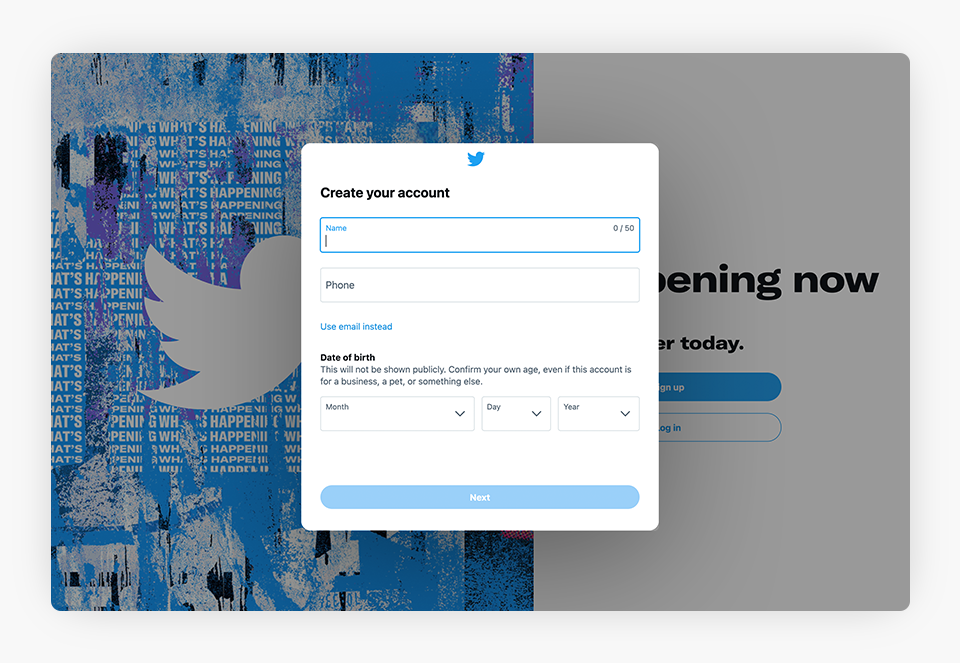
Once you have created your law firm’s Twitter account, you should promptly finish the basic setup. First, you should choose a profile photo that represents your brand and fits nicely in the small space allotted. For many firms, this profile photo is your logo, but if you have a “face of the firm” you can use a photo of that person too. The recommended dimension for this photo is 400X400 pixels.

Next, you should select the header photo for your firm. This is similar to the cover photo that appears on your law firm Facebook account. This cover photo should align well with your brand and accurately represent your firm. You could consider an abstract photo, such as a courthouse, a group photo of members of your firm, or something else that falls within your brand guidelines. This photo should be 1500X500 pixels.
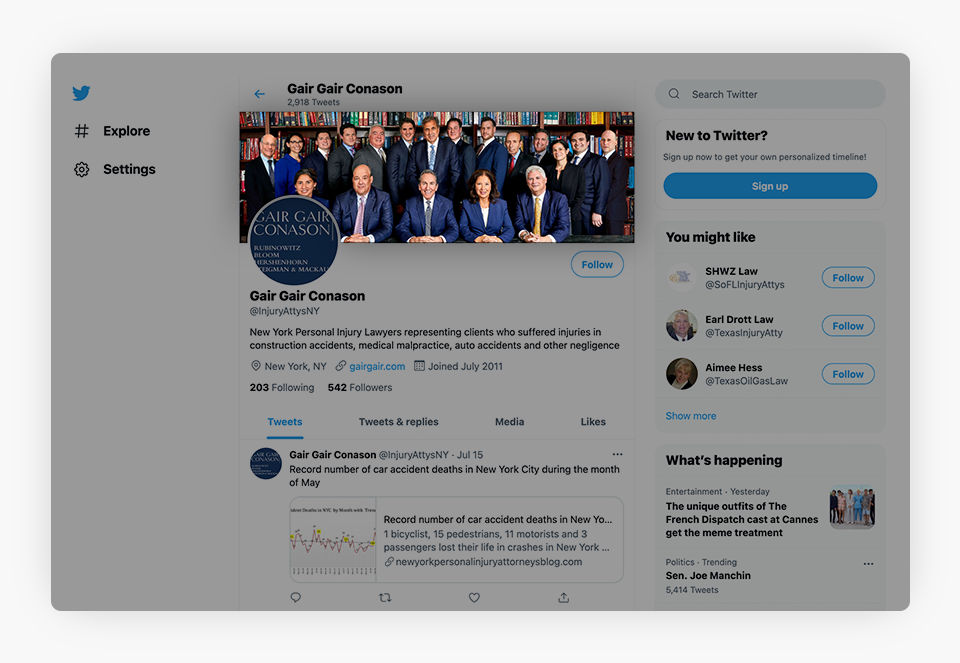
Next, you should edit your display name and account name (also sometimes referred to as a username or handle). Your display name appears as your name on Twitter. It can contain up to 50 characters and should be the name of your firm or the shortened version of your firm name that is permissible according to your brand assets.
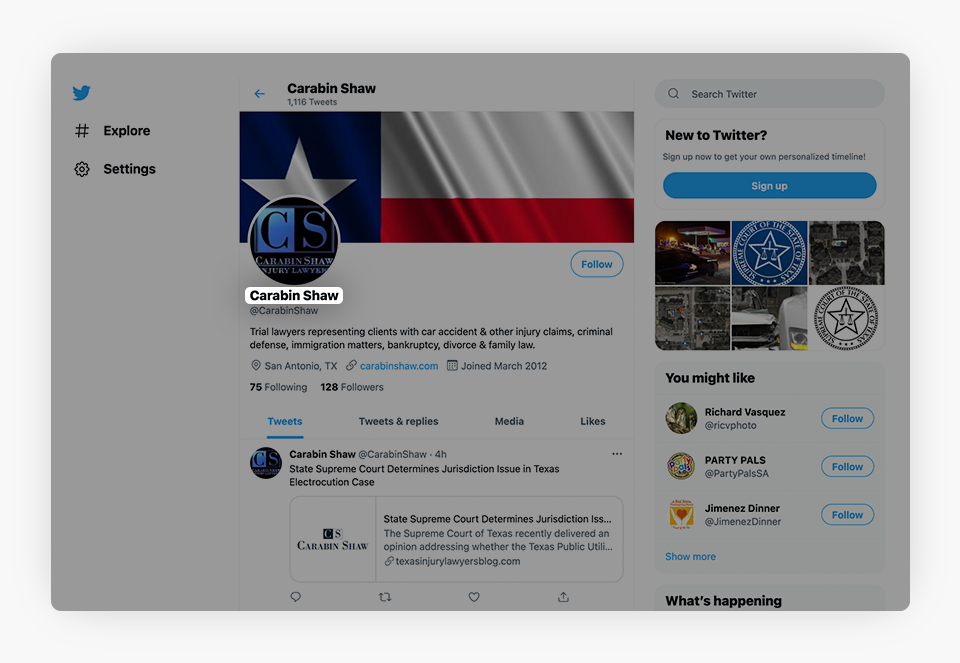
Your account name is what follows the @ symbol commonly seen on Twitter. This will be associated with everything you do across the platform, and can also be used by others to mention your law firm. It can contain up to 15 characters and should be easily associated with your law firm.
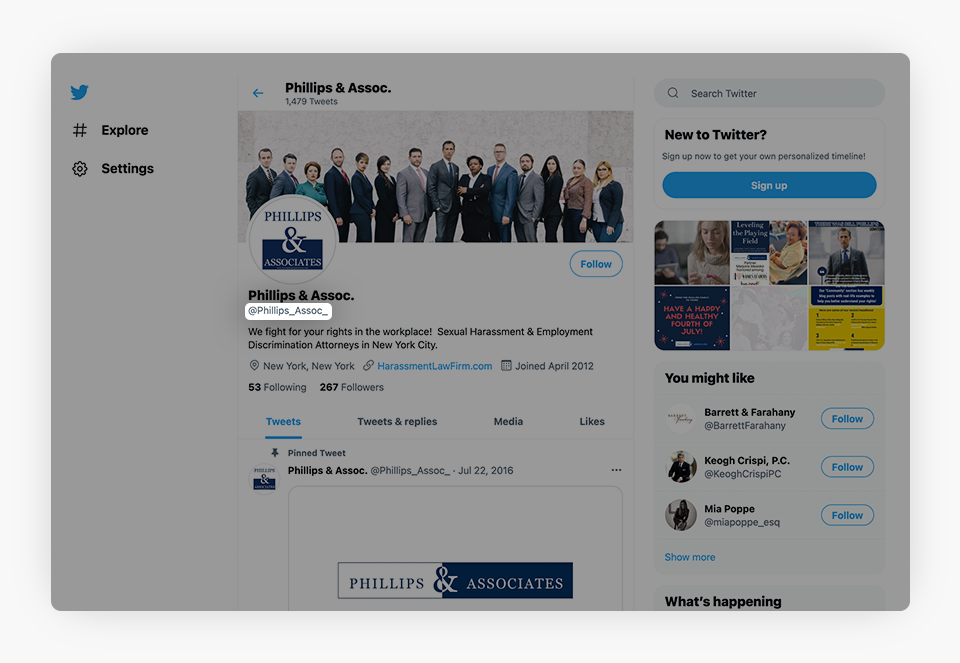
After choosing your names, you should add a biography to your profile. This is a very short biography – only 160 characters – so you simply need to give a small introduction to your law firm. You should also add a link to your website and include the location of your primary office.
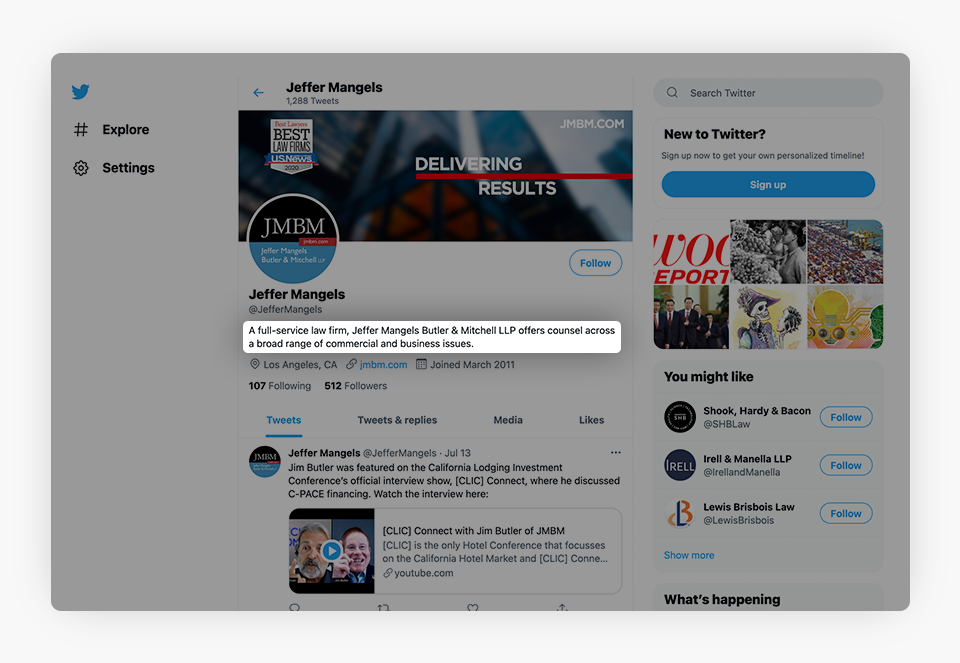
Planning for Use
Once you finish these basic steps, you are prepared to move towards using your new law firm Twitter account. However, there are a few more steps and planning strategies to consider before you start sending messages out into the world.
First, start following other accounts. You could follow national and local political figures, such as your governor or the president. Follow your state and local bar associations. Consider following important agencies, such as the Department of Justice or the judicial district in which you practice. If you need additional ideas on who to follow, check out the accounts other law firms in your area follow. However, avoid following random individuals that do not have an association with your firm and overly controversial figures from your law firm account.
You can also invite your colleagues, clients, and friends to follow your account. Engagement is very important for effective social media use, so you need followers that will engage with your content.
At this point, you are almost ready to start tweeting. However, you do need to develop a strategy for engagement on your page. Outline a schedule for posting designed around high-engagement times. Determine the type of content you would like to post. Your tweets do not always need to sound like ads or an obvious promotional tool. In fact, you should avoid over-selling your services on Twitter.
Instead, you need a healthy mix of content that is weighted more heavily toward information and announcements. You can repurpose your blog content into tweets.
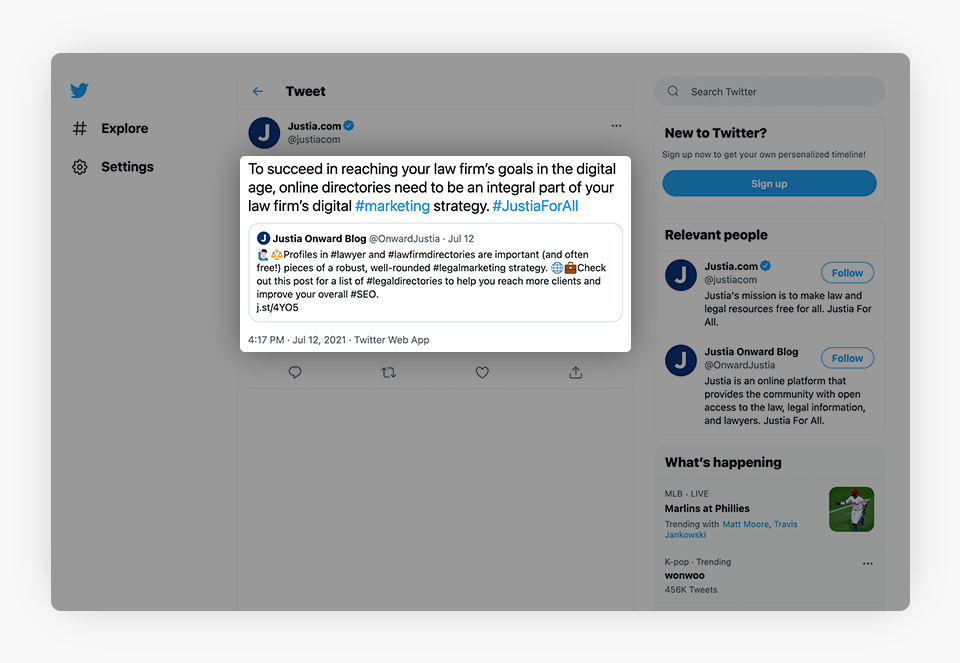
You can retweet relevant information shared by others. You could even highlight employee achievements and accomplishments. However, remember that Twitter has a short, 280 character limit so you need to share your message very concisely on the platform.
Visuals are very effective on Twitter and you should take care to include images or videos with your tweets. These tweets will typically receive higher engagement than a standard text-based message. Therefore, you need to plan the visual and graphic elements you will use with your tweets.
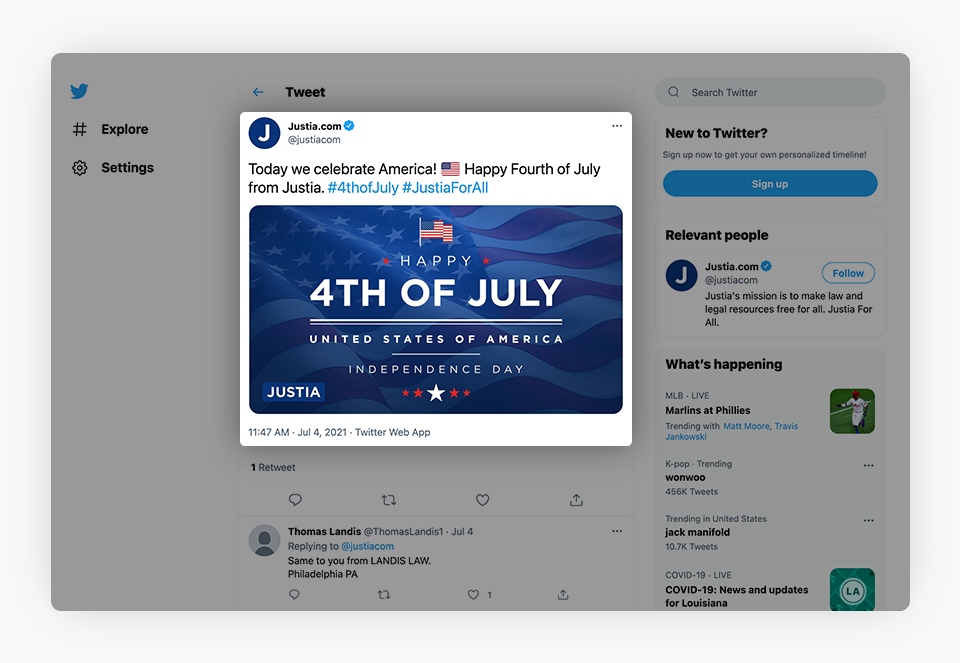
You can leverage hashtags to increase the reach of your tweets. For instance, if you Tweet about a United States Supreme Court decision, you could use the #SCOTUS tag. Do a little bit of planning to ensure you understand the background of any hashtag you intend to use and it is relevant to your tweet.
Finally, you should also consider the reach of your Twitter presence beyond simply sharing messages with your potential clients. For instance, you can use Twitter to build your firm’s reputation and position your attorneys as experts in your field by using the platform to reach out to journalists (as most are on Twitter). We will cover the benefits of working with the media and how to use Twitter to reach out to media professionals in a later blog post.
Using Your Account
Once you have a preliminary background and framework in place, you are ready to start tweeting! You have done the hard work of outlining your plan and can simply choose a topic to share with your new followers, remembering the best practices discussed above. There are just a few more things to keep in mind moving forward:
- Consider a Pinned Tweet: Once you have sent a few tweets, you can choose one to pin at the top of your account as a greeting for visitors in the future. Make sure you update this from time to time, so it does not go stale.
- Engage With Other Users: You do not always have to create your own messages. You can retweet content that is relevant to your firm, such as a new regulation impacting your practice area. You can retweet holiday announcements or reply to tweets about breaking news, such as new legislation in your state. Join the conversation at legal conferences and events.
- Don’t Feed Trolls: Stay mindful of reputation management for user feedback. You may get negative engagement or other harsh comments from critics. You will not win a social media fight with an anonymous person on the internet. Don’t engage with the troll and remain professional. Also, do not be a troll by starting unnecessary twitter fights.
- Know Who is Posting: You will want to make sure that anyone posting on the firm’s behalf is responsible and trustworthy. This is especially true if you are hiring an outside company to handle your social media. You do not want someone posting something unrelated to your account’s purpose, or even worse offensive to your audience and the public. Your law firm does not want to become a case study of a tweet gone awry, such as what happened to Chrysler when an outside consultant sent a tweet attacking Michigan drivers.
- Remember Your Ethical Obligations: Stay up to date on the ethical rules governing attorney advertisement in your jurisdiction(s). You do not want to run afoul of any professional obligation through your social media use.
- Consider Paid Solutions: Twitter offers paid advertising solutions for businesses that you may want to consider as part of your future campaigns. This can help you showcase your content and reach more potential clients across a broader audience.
Final Thoughts: Why Do You Care?
Creating your law firm’s Twitter account offers you yet another free channel for reaching your potential clients and strengthening your firm’s brand. Leveraging free resources, like social media profiles, to expand your digital reach is a great way to help expand your practice’s online visibility and continue your law firm’s growth into the future.
